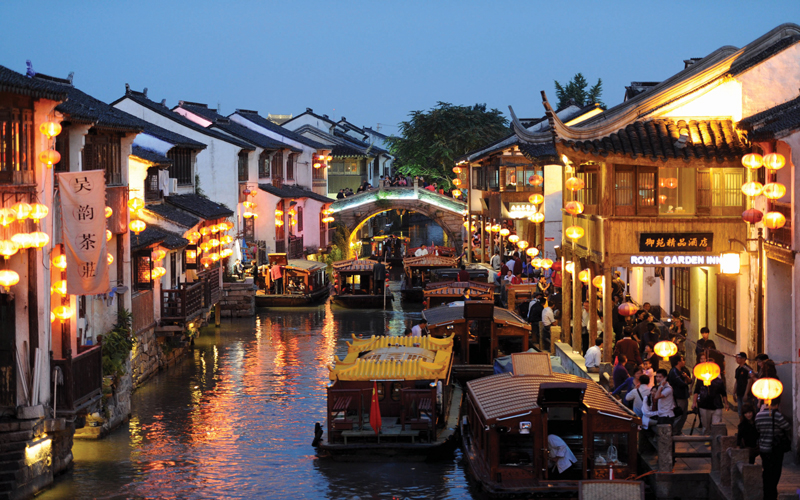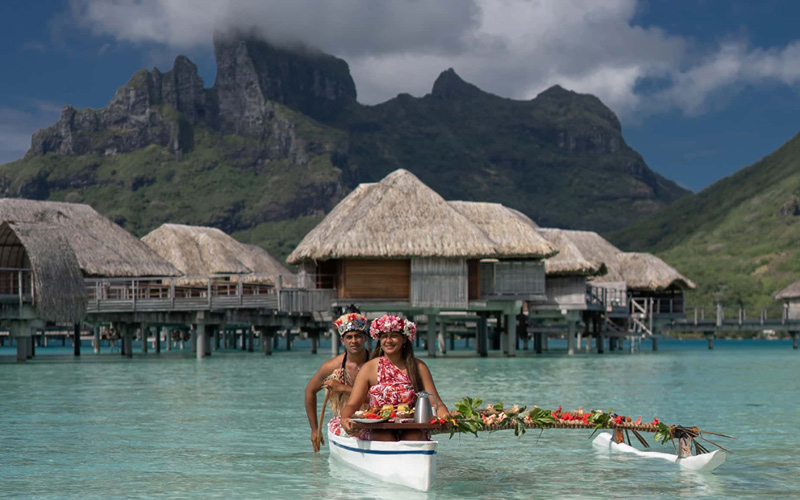Suzhou, China’s Earthly Paradise
Only 70 miles west of Shanghai, China’s high-tech metropolis, Suzhou is a world apart,

a wonderland of lush classical gardens, age-old canals and winding rivers, and revered cultural institutions. The graceful city that once attracted ancient emperors and court officials, artists and poets, still draws Chinese vacationers as well as savvy Westerners.
Suzhou – pronounced “sue-joe” – is easily reached. Airlines fly regularly from major U.S. and Canadian gateways to Shanghai. Take the high-speed Maglev train into the city and visit mega-tall skyscrapers and elegant 19th-century European buildings along the riverside Bund. Or proceed directly to Suzhou. From Shanghai’s Pudong International Airport or Hongqiao International Airport, bullet trains make the 30-minute trip.
Knowledgeable English-speaking guides will certainly enhance your visit. My small group was led by More Fun Asia (www.MoreFunAsia.com).
From Shanghai’s Pudong International Airport, we arrive in Suzhou 90 minutes later. East of the historic district, we check into Suzhou’s newest hotel, the 379-room W Hotel Suzhou (www.whotels.com) in the glass-fronted Suzhou Center mall. Overlooking Jinji Lake, it’s in Suzhou Industrial Park (www.sipac.gov.cn/english) featuring scores of restaurants, several upscale shopping malls and China’s largest overwater Ferris wheel.
SUZHOU’S GLORIOUS GARDENS
For 600 years, from the Ming through the Qing dynasties, Suzhou became famous for classical gardens, artfully contrived miniature landscapes featuring four essential elements: flowers and trees, water, ornamental stones and buildings. As many as 200 gardens once flourished in Suzhou, China’s “earthly paradise.” Today, nearly 60 restored gardens remain, nine listed as UNESCO World Heritage Sites.
After enjoying seafood at the W Hotel’s Su Yan restaurant, we explore the 13-acre Humble Administrator’s Garden, Suzhou’s largest and most famous garden, built in 1509 by a retired Ming Dynasty official. A Tai Chi master and his disciple demonstrated that martial art’s balletic movements as we strolled through a charmed landscape of koi ponds, cherry trees, and elegant pavilions like the Hall of 18 Camellias, adorned with pots of flowering pink and
red camellias.
Following lunch at nearby Yuanwailou Hotel (www.ywl-hotel.com), we board a long flat-bottomed boat to cruise the Grand Canal. Over 42 percent of Suzhou is covered by water, prompting Marco Polo to call the city the “Venice of China.” The 2,000-year-old Grand Canal, a UNESCO World Heritage Site, is the world’s longest man-made waterway, stretching 1,200 miles from Beijing south to Hangzhou. Cruising under ancient stone bridges you’ll experience the canal’s venerable grandeur.
We dock at Tiger Hill Scenic Spot, Suzhou’s number 1 attraction, with three acres of gardens and woodlands, including gnarled black pines and China’s bonsai-style penjing trees. The centerpiece is Yunyansi Pagoda, a 156-foot white-brick pagoda built in 959 A.D. The 6,000-ton structure leans north to east, China’s version of the Leaning Tower of Pisa.
Back in Suzhou’s historic center, we browse shops along Pingjiang Road, home to the famous Couple’s Retreat Garden, surrounded on three sides by water. Perched in the rickety wooden balcony of Fu Xi Teahouse, we sip tea and listen to the high-pitched yet melodic strains of kunqu opera. A UNESCO Masterpiece of the Oral and Intangible Heritage of Humanity, kunqu is one of China’s oldest operatic forms.
TEA & TOURING TONGLI
Tea cultivation is yet another Suzhou art. The next morning, we drive west to a tea plantation at Dongshan Mountain overlooking Lake Tai. Climbing low-lying hills, we pick spring’s first green shoots of Bi Luo Chun, China’s finest green tea. Loaded with antioxidants, floral-scented Bi Luo Chun is believed to cure everything from cavities to cancer.
We head to the Master of the Nets Garden that night. At 1.3 acres, it’s Suzhou’s smallest, and perhaps choicest, classical garden. Built in 1140 by a retired Song Dynasty official, it evokes a fisherman’s simple life. Passing through four halls, where a succession of musicians and singers perform, we enter an inner courtyard where pavilions, dramatically outlined in twinkling white lights, surround a central pond. It’s utterly spellbinding.
Come morning, we’re off to the famous Lingering Garden. Built in 1593 by a Ming Dynasty official, the undulating landscape resembles imperial Chinese hunting grounds. Almost immediately, we’re transfixed by a musician playing a bamboo flute as he’s rowed across a pond in a long wooden boat. In the Celestial Hall of Five Peaks, eight women virtuosos, in elegant blue-and-white dresses, play ancient lutes called pipas. Around the 21-foot-high Auspicious Cloud Capped Peak, a famed limestone monolith, three women in flowing purple, yellow and light-blue gowns sing and dance with colorful silk fans.
Fan-making is another Suzhou art, and we find well-made fans and other souvenirs in Shantang Street’s canal-side shops. We lunch at Songhelou, the 250-year-old restaurant beloved by Qing Dynasty Emperor Qianlong.
There’s time for a rickshaw ride before returning to the W Hotel to sample the WOOBAR’s spring cocktail lineup and visit the Suzhou Center’s designer shops and restaurants as well as its ice-skating rink, indoor ski slopes and glassed-in riding ring. At Mei Mei, in Jinji Lake’s trendy Ligongdi district, Cantonese dishes await us, including shrimp dumplings, shellfish soup, lotus root with pork, and whole trout.
The next morning, we’re at the No. 1 Silk Factory, the city’s oldest operating silk mill, established in 1926. From silk worms munching mulberry leaves to weaving looms, the factory offers fascinating demonstrations of silk-making, a Suzhou art dating back to the seventh-century Tang Dynasty.
By afternoon, we’re in Tongli (www.tongli.net), one of six “water towns” surrounding Suzhou, 11 miles northeast. The “Oriental Venice,” Tongli is famous for canals lined with Ming and Qing dynasty temples and pagodas, as well as the 19th-century Retreat & Reflection Garden, a UNESCO World Heritage Site.
We hop a gondola for a 25-minute canal cruise beneath old stone bridges with names like Peace, Luck and Celebration, and along narrow waterways lined with quaint wooden shops and open-air eateries.
Though Tongli is known for seafood, we choose innovative vegetarian fare, including spring rolls and bamboo-egg drop soup, at Xishantang, run by Buddhists in a stylishly decorated 400-year-old silk-merchant’s house.
Back at Jinji Lake, we browse upscale boutiques at Suzhou Industrial Park’s Harmony Times Square. Then it’s off to nearby Tonino Lamborghini Hotel (www.tlhotelsgroup.com), a boutique hotel designed by the Italian automotive heir. At the French restaurant LE LAC, overlooking Jinji Lake, we savor steaks, chops and seafood at a specially designed “water table” with a flowing stream. The surrounding hotel garden is adorned with camphor trees, ornamental stones, circular moon gates and waterfalls. It’s the perfect blend of natural and manmade artistry, of earth and water, of old and new. It’s the perfect farewell to Suzhou.
www.traveltosuzhou.com




